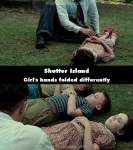Corrected entry: On the approach to the island on the ferry, Leo has both a wedding ring on and no ring on his finger at alternating times.
Corrected entry: When Edward meets with Rachel in the cave, she talks about "Sodium Amytal, an opium-derived sedative". Sodium Amytal is a barbiturate which has no chemical relation to opium.
Correction: Because Dr. Rachel is a figment of Teddy's psychosis, this isn't really a mistake, as it just means that Teddy's doesn't have the most up-to-date info on the newest drugs.
Corrected entry: Leo was a United States soldier who talks about liberating Auschwitz, when in reality Auschwitz was liberated by the Soviet Red Army. (00:42:30)
Correction: He talks about liberating Dachau, not Auschwitz.
Corrected entry: Although the movie is set in 1954, the front wheels of the warden's Jeep had distinctive locking hubs that were not introduced until the 1970s.
Correction: This is incorrect. Willy's Jeep introduced locking hubs in the WW2 editions of the jeep.
Corrected entry: When Teddy is interviewing the lady patient, she picks up the cup and it has nothing in it, but when she puts the cup down it has water in it.
Correction: If you watch the scene again you will see that Chuck hands her a glass of water. When she goes to take a drink her hand is empty "no glass at all". She then sits a empty glass down. The next scene shows the glass sitting on the table half full (half empty for the PC people).
Corrected entry: In the lighthouse scene, the critical prop for the pivotal moment was an item that did not exist in 1954: a whiteboard.
Correction: This isn't a whiteboard, it is a flipchart of sorts, with white paper on it. If you look along the top there are hooks holding the paper in place.
Corrected entry: In the scene with the dying German officer lying on the floor, his gun is lying by his left hand - the same side as the big EXIT wound in his head. The gun should be by his right hand.
Correction: The German officer is alive when 'Teddy' enters the office, and dies shortly afterwards. Head wounds are bizarre things - he could have walked a few steps after shooting himself, or gone into convulsions, or the gun could have been dislodged by a cadaveric spasm due to his massive brain injury. There are lots of explanations - any one of them works.
Corrected entry: At the end of the movie Teddy is sitting on the steps of the building and Chuck approaches, sits with him and offers him a cigarette, and takes one himself. As Chuck takes his out of the pack of Lucky Strikes the cigarette has a filter. Lucky Strikes did not have filter cigarettes in the 1950s.
Correction: Watch the scene again. It is a plain white, unfiltered cigarette. The best view is at 2.02.53 when the cigarette is visible, framed against Andrew/Teddy's dark blue trousers.
Corrected entry: When Teddy's wife walks over to the window and looks out onto the lake and the sunset, she is talking to Teddy. The shot switches to see her face where she is still talking. Then the shot switches back to Teddy's point of view and we see her turning around. The audio still has her talking, but her mouth isn't moving as she turns.
Correction: Pretty much every interaction he has with his wife has been in his troubled psyche. There is no logic or reality involved when the actions are created in the mind of a mentally ill person. Its entirely possible that he was able to "hear" her thoughts. Although I agree that the mistake was unintentional on the part of the filmmakers, since its not "real" it can't truly be counted as a mistake.
Corrected entry: Toward the end of the movie, when Teddy is going to the lighthouse to rescue his partner, he is seen jumping over a wall. He lands in a large amount of fallen leaves. As he does so, the edge of the mat that breaks his fall is visible beneath them.
Correction: Everything teddy does is set up so would make sense that they would take care to protect him as much as possible, the mistake may in fact be part of the setup, not a filming error, teddy wouldn't have known what he landed on.
Corrected entry: Edward has several flashbacks to being one of the soldiers who liberated Dachau. Many of these show piles of bodies encased in ice and heavy falling snow. Dachau was liberated on April 29th, 1945. Snow would have been a possibility, but photos taken at the time show no ice or snow and certainly no heaps of ice-covered bodies.
Correction: By all historical accounts, the pre-dawn liberation of Dachau took place during a late spring snowstorm, and additional troops arriving in the morning also reported a fresh blanket of snow, so the depiction of snow at Dachau is not a mistake.
Corrected entry: When Teddy starts to chase the crazy guy in the C Building, he hits a wall and yells to the crazy guy "hey, heeeeyyyy!" and immediately after this the shot is repeated, Teddy hits the same wall again and yells again. (01:04:55)
Correction: I've watched this a few times, both in context and out of context. It's not a mistake; it's one of the many techniques used to create atmosphere in this movie, just like the intentional continuity and missing cup errors in the interview scene earlier.
Corrected entry: When Teddy was administering CPR to his daughter in the lake, he used a method that was not in common use yet. The scene is set in 1952, but the rescue breathing method he used was only experimented with in 1952.
Correction: If the technique did exist (even if it was only experimental), there is a chance Teddy could have heard of it and/or seen it demonstrated.
Corrected entry: Before they go to Ward C, it says all the power has been cut, so how were there lights flickering in Ward C? Also with the power cut, only some prisoners were out of the cells, not all.
Correction: The lights are flickering because the work crews are trying to get the power back on. The guard they meet when they go into ward C specifically states they've rounded up most of the prisoners but not all. We can assume the ones they've recaptured have been put back into their cells and the doors manually secured.
Corrected entry: When Andrew Laeddis is shown he has surgical staples across his face. Surgical staples were not used until 1960.
Correction: Surgical stapling was introduced in the early 1900s. It was pioneered by Humer Hultl, who introduced a prototype surgical stapler in 1908.
Corrected entry: I think the the narrator tells us that Shutter Island is located in Boston Harbor and also that it is eleven miles off the coast! A harbor 11 miles off the coast? please.
Corrected entry: When Leo is talking about the massive killing at the concentration camp of the German soldiers, we see the camera run along as the US soldiers shoot them. At the end of the line, one of the German soldiers can be seen smiling for a brief moment after he falls down.
Correction: It's a grimace, not a smile.
Corrected entry: In the flashback of Teddy where he is staring at the dying German officer who tried to commit suicide, the camera shows (from the gun's perspective) as the officer reaches for the gun. On his hand he wears a wedding band, but in Germany the wedding band is worn on the right hand.
Corrected entry: When Teddy is dreaming that he is in the office and he sees Rachel and some dead kids, the smoke from the cigarette goes backwards. (01:30:05 - 01:50:00)
Correction: This is done intentionally, he's in a dream. It would be impossible to make smoke go backwards without visual effects work.







Correction: This is intentional. The ring is a symbol indicating when and when not Teddy is caught in his delusions. When the ring is on he is delusional, thinking he is the marshal finding out all the dark secrets of the facility. When the ring is absent he is lucid and aware of his past crimes and his own delusions.
MovieFan612 ★